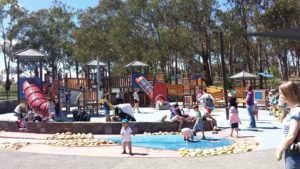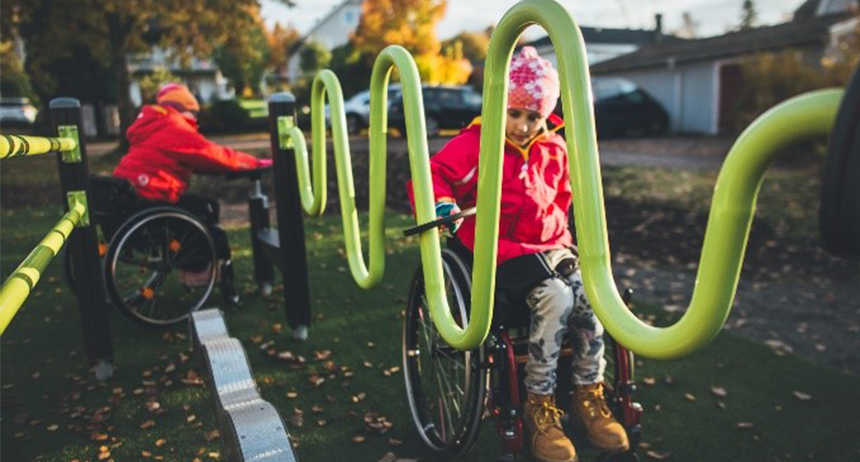
There has been a large shift within local government, who have now put policies into place, to design new or upgrade existing play spaces so they are inclusive and suitable for people of all abilities.
Having play or sporting activities that can be utilised by all age groups and skill level is a great way to bring the community together.
Within this document, we will look at why it is important to have inclusive playgrounds and what factors to consider when designing one.
What is an inclusive playground?
Inclusive playgrounds are designed to make them such that it is easy for everyone to move and play in them, which encourages all children to play together
The aim has been to implement the Inclusive Design properties in such a manner that the play equipment is suitable for as many children as possible, regardless of potential functional or physical impairments
All children will not always be able to participate in all of the activities, but in an inclusive playground there should always be a real choice of play activities for all children
Designs should take into account;
- physical challenge
- functions stimulating different senses
- opportunities for everyone to develop social skills
- learn something new
Who are people with disabilities?
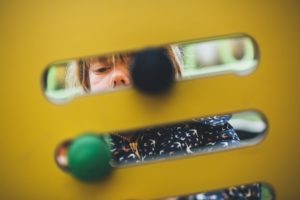 People with functional and physical limitations means people whose ability to move, function, orientate themselves or communicate is permanently or temporarily impaired due to a disability or illness.
People with functional and physical limitations means people whose ability to move, function, orientate themselves or communicate is permanently or temporarily impaired due to a disability or illness.
The causes of the impairment can be numerous:
- Weak eyesight or blindness. Most people with visual impairments can see to a certain degree. Only 10-15% of them are totally blind
- Becoming deaf, deafness, hearing loss, deaf-blindness and multiple hearing disabilities
- Impairment of functional capacity, such as musculoskeletal disorder, rheumatic disease, cerebral palsy, muscular disease, dwarfism, etc. Only 10–15% of the physically disabled are wheelchair users. Moreover, some of these individuals can stand up and walk (with support) short distances
- Intellectual and developmental disability, often associated with multiple disabilities, physical disability, visual and hearing impairments
Importance of physical playing
 A lack of stimulation can prevent the automation of skills and slow down later stages of development
A lack of stimulation can prevent the automation of skills and slow down later stages of development- By giving stimulation children’s motor learning can be improved
- The most essential basic motor skills and motion combinations the child will learn before the beginning of its schooldays (6 years)
- Age 7 to 12 is the period in which children’s capability to learn motor skills increases fast
- This is the best time for learning physical skills!
- Development of cognitive skills
- Many studies show the relation between physical activity and cognitive skill development
- Social skills
- Play is supporting cognitive and socio-emotional learning
- Through play children learn important skills, such as negotiating, playing in teams, risk taking, overcoming obstacles, understanding of dissimilarity
- They will have the chance to develop friendships and sense of belonging to a peer group
- For children with disabilites, sense of belonging is especially important as they are often marginalised and or overprotected
Inclusive Design Properties
Sufficient colour and tone contrasts, good lighting
-

Play equipment should be available in various colours and tones. It is important that the contrast between the equipment and the background is good; for example, if a product is placed next to a green shrub, people with impaired vision should also be able to discern it from the shrub. The ground (safety surface) under the equipment, as well as the passageways, should also contrast in tone with the rest of the area. A tonal contrast zone around the equipment also lets people with impaired vision know that the products are near
- The parts of each product should also be easy to differentiate – for instance, the tonal contrast between the support poles and the rest of the product should be prominent
- Playgrounds and equipment areas should be well lit
Passageways and their materials
- The surface of the passageways on playgrounds should be hard, even and nonslip, and it should stand out from the environment through its tonal and / or material contrasts. Passageways should be wide enough for unrestricted passage with a wheelchair and any other auxiliary equipment. To facilitate moving around, handrails by the passageways are a good idea.
- The passageways should be well lit
Ramps
- Any ramps on the passageways should be of sufficiently low gradient – preferably sloping no more than 6%. If there is a chance of slipping off the ramp, the ramp should be equipped with elevated edges
Seats, tables and platforms
- A playground should offer seats of various heights, with backrests and armrests – something for people of all ages and heights
Play equipment
- Slides should be wide enough for a guardian or assistant to accompany an impaired person. Playhouses should be accessible by wheelchairs. The visibility of the first step of each product should be improved with contrast colours and lighting
Support poles
- Many products are equipped with poles, which can be used as support (steps, climbing frames) or as handles to hold on to, to stay on the equipment (carousels). For a child to be able to get a sturdy grip on a pole, it should be narrow enough for a child’s hand
Instructions
- A playground should have instructions, which can be visual, aural or tactile. The instructions should serve all people with impairments, and they should explain what the playground offers and where the passageways are. Tactile instructions, with embossed elements and Braille, should be available for people with impaired vision
Adult and Senior Equipment
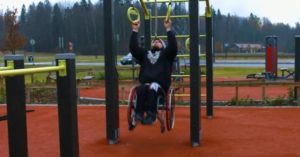 Sporting or exercise equipment for adults should also follow Inclusive Design principals. The equipment should be able to support the user during the activity, but also have a large enough area around the equipment so wheelchairs, walking devices or a career can move freely throughout the space
Sporting or exercise equipment for adults should also follow Inclusive Design principals. The equipment should be able to support the user during the activity, but also have a large enough area around the equipment so wheelchairs, walking devices or a career can move freely throughout the space
Equipment for seniors should also reflect the same Inclusive Design properties as they do in playgrounds. Consider multi-generational equipment which lets seniors use the products to keep active, but children can also use this equipment to play on
Individual equipment which may have been designed with seniors in mind, can be also used for rehabilitation, or in play spaces for children or for older participants where you lessen the challenge or risk. Equipment like this is great for any age with less ability, to help with joint movement
What do I need to remember?
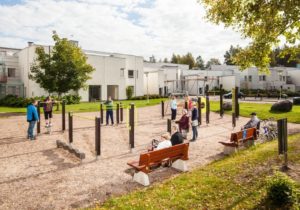 Designing a play space that is inclusive is great, but if the environment is not suitable people won’t use it;
Designing a play space that is inclusive is great, but if the environment is not suitable people won’t use it;
- Is the park close to public transport
- Is there enough parking
- Is the park enclosed and secure
- Are there any facilities or amenities available
- Are footpaths, entry points and access to the play equipment wide enough for a wheelchair
- Is there shade
- Are play surfaces safe and will cushion children if they fall
- Are surfaces even enough for wheelchairs to navigate easily
- Are there different activities and challenges available ie climbing, balancing, sliding etc
- Is there enough colour contrast between the equipment and surfaces
- Is the equipment combined so that not one piece is left on its own
- Is there a space for children to congregate, play together and use their imagination
- HAVE FUN!
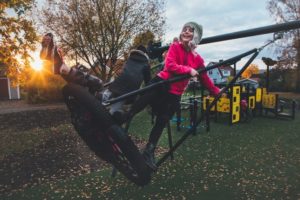
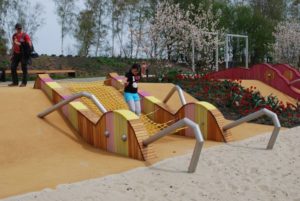 A lack of stimulation can prevent the automation of skills and slow down later stages of development
A lack of stimulation can prevent the automation of skills and slow down later stages of development